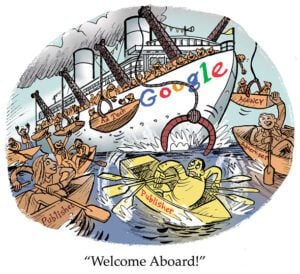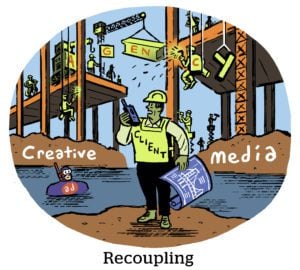VideoAmp isn’t feeling as amped up about its future as it was last year.
The startup may have established itself as one of the top alternative currency contenders among TV ad measurement providers in 2023, but the pressure to win market share is causing cracks in its shiny facade.
VideoAmp laid off 20% of its staff last week amid a reorg. Founder and CEO Ross McCray also stepped down, replaced (for now) by board member Peter Liguori.
This is VideoAmp’s second round of layoffs in less than five months. In September, the company cut its workforce by 10%.
It turns out that, behind the scenes, VideoAmp’s alt TV currency business hasn’t been growing as quickly as headlines suggest. Instead, the would-be neutral measurement company makes most of its money from activating client campaigns, and struggles to be profitable without the easy money this line of business generates. The company is burning cash and recently slashed its year-over-year revenue projections, which is why it’s been forced to lay off so many staffers, a source with knowledge of the matter told AdExchanger.
VideoAmp raised more than $600 million in funding over the past decade – the latest being its $150 million Series G funding round in September – but that funding wasn’t being sufficiently deployed to grow its currency business, a former employee said, also noting that VideoAmp had severely overhired.
VideoAmp CMO Jenny Wall spoke with AdExchanger at CES and confirmed the company’s headcount was too big. It had to reduce staffers while automating more of its business operations but, Wall said, last week’s layoffs didn’t affect the product and engineering teams.
VideoAmp isn’t alone in its struggles, either. Nielsen also cut its workforce by roughly 10% in September.
But there are company-specific reasons why VideoAmp is having trouble finding its footing.
Picking sides
Alt currencies are already operating on a tough playing field.
Buyers continue to rely on Nielsen because it’s familiar, and there simply isn’t enough money left to circulate among all of Nielsen’s competitors, the former employee said. It also doesn’t help that Nielsen has delayed dropping its legacy ratings (average commercial minutes), which advertisers have used for decades.
The problem with VideoAmp in particular is that it has made most of its money from activation, both sources said.
Although VideoAmp has a demand-side platform and touts its origins in ad tech as a competitive advantage among currency providers, the TV industry at large considers the selling of both media activation and measurement to be a clear conflict of interest.
Some VideoAmp clients find this practice “problematic,” said another previous employee.
Keenly aware of this sentiment, both Comscore and iSpot tout the fact they don’t sell any media.
And although Nielsen used to do media activation, it sold its advanced video advertising business – including its dynamic ad insertion and automatic content recognition technologies – to Roku in 2021.
To survive as a media and advertising company, VideoAmp needs to divest either its activation or its currency business, advised one source – but therein lies the rub.
“It wouldn’t be financially viable for [VideoAmp] to get rid of its activation business,” the same source said.
Several ad execs echoed these observations anonymously to AdExchanger on the ground at CES this week.
But, to its credit, VideoAmp says it’s transitioning more of its resources away from activation and into measurement and currency instead.
Specifically, the company’s plan has been to make enough money off of media activation to fund its currency business, Tony Fagan, who was promoted to president of technology and strategy as part of the reorg, told AdExchanger at CES.
Fagan added that, as a result, VideoAmp’s media activation business is smaller than it was when he first joined the company in 2021.
Right now, VideoAmp is “putting all of its eggs in the currency basket,” Wall said.
Seeking status
And, to be fair, VideoAmp has been able to gain at least some market share in the TV currency space among both programmers and agencies over the past year.
Major programmers like NBCUniversal, Warner Bros. Discovery and Paramount all cite advanced audiences as a primary reason for using VideoAmp. The broadcaster joint industry committee also gave the company conditional certification for its transparent census-level data in September, alongside Comscore and iSpot.
But there’s a related reason behind why VideoAmp is having financial trouble. Courting clients and inking new partnerships can be a pricy endeavor, and VideoAmp spends an enormous amount of money entertaining customers and prospects. Its lavishness is eyebrow-raising, even in the media world.
Put it this way, one source said: “A client dinner is one thing. A client vacation is another.”
Good data, bad decisions
Meanwhile, VideoAmp has undergone multiple restructurings of its business over the past two years, a signaling of uncertainty at the leadership level, according to one source.
The result is a disjointed company with unstable business divisions.
For example, there’s a big disconnect between the company’s marketing and its data and research teams. VideoAmp is more concerned about making sales (remember those client vacations?) than building its brand reputation. Despite a push from its marketing staff, it hasn’t been actively publicizing enough viewing data to market itself to prospective clients, according to two sources.
It’s therefore not surprising that last week’s layoffs hit marketing and communications especially hard, according to one source. But frequent reorgs threaten the entire company because they nearly always result in staff reduction and have a negative impact on morale.
“Everyone is constantly worried about [getting] fired,” one employee wrote on Glassdoor in June while still working there.
The ‘in’ crowd
Some VideoAmp employees also took issue with the company culture, even during better times.
“[Leadership] was proud of touting that VideoAmp is not for everyone,” said one former employee. “They wanted a very specific type of person to work there: Aggressive, determined, hungry and ready for anything.”
The social exclusivity didn’t sit right with many, “as you can see on Glassdoor,” the same source added.
These Glassdoor snippets from former employees paint quite the picture: “textbook toxic tech bro environment” and “think CrossFit-meets-frat-house.”
What next?
With its founder stepping down, VideoAmp is pinning its hopes on its new leaders.
In addition to promoting Fagan and elevating Liguori to executive chairman, VideoAmp tapped 25-year Nielsen vet Peter Bradbury as its new chief commercial and growth officer, an ironic turn of events considering how much time it’s spent dissing Nielsen’s methodology.
Bradbury is a “formidable leader” in the TV measurement space, one source said, and was involved in Nielsen’s decision in 2021 to divest its advanced video advertising business in the name of fair measurement.
VideoAmp also promoted Josh Hudgins to chief product officer as part of its leadership reshuffle.
Still, the company has a difficult task ahead. It needs to cut costs, create an inclusive work environment and establish church and state between media activation and measurement.
Only then can VideoAmp ensure a fighting chance at becoming one of the industry’s go-to video currencies.

















